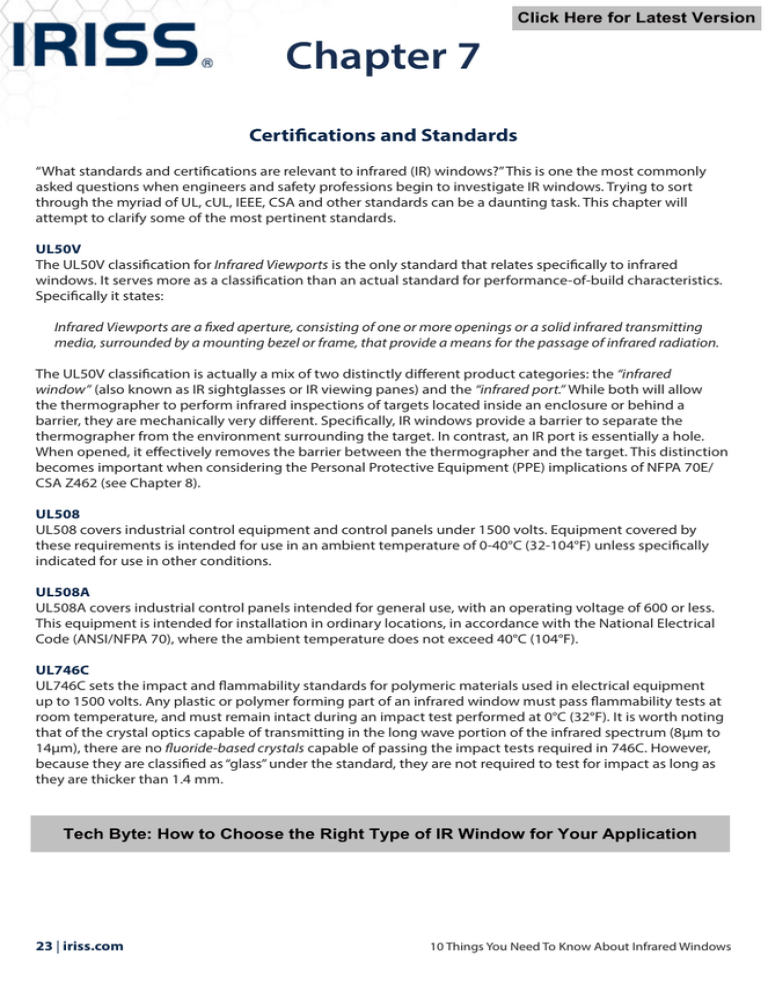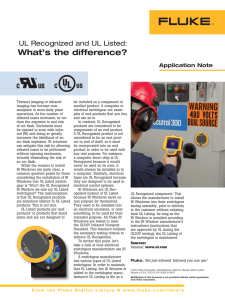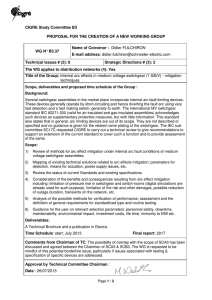
Click Here for Latest Version
Chapter 7
Certifications and Standards
“What standards and certifications are relevant to infrared (IR) windows?” This is one the most commonly
asked questions when engineers and safety professions begin to investigate IR windows. Trying to sort
through the myriad of UL, cUL, IEEE, CSA and other standards can be a daunting task. This chapter will
attempt to clarify some of the most pertinent standards.
UL50V
The UL50V classification for Infrared Viewports is the only standard that relates specifically to infrared
windows. It serves more as a classification than an actual standard for performance-of-build characteristics.
Specifically it states:
Infrared Viewports are a fixed aperture, consisting of one or more openings or a solid infrared transmitting
media, surrounded by a mounting bezel or frame, that provide a means for the passage of infrared radiation.
The UL50V classification is actually a mix of two distinctly different product categories: the “infrared
window” (also known as IR sightglasses or IR viewing panes) and the “infrared port.” While both will allow
the thermographer to perform infrared inspections of targets located inside an enclosure or behind a
barrier, they are mechanically very different. Specifically, IR windows provide a barrier to separate the
thermographer from the environment surrounding the target. In contrast, an IR port is essentially a hole.
When opened, it effectively removes the barrier between the thermographer and the target. This distinction
becomes important when considering the Personal Protective Equipment (PPE) implications of NFPA 70E/
CSA Z462 (see Chapter 8).
UL508
UL508 covers industrial control equipment and control panels under 1500 volts. Equipment covered by
these requirements is intended for use in an ambient temperature of 0-40°C (32-104°F) unless specifically
indicated for use in other conditions.
UL508A
UL508A covers industrial control panels intended for general use, with an operating voltage of 600 or less.
This equipment is intended for installation in ordinary locations, in accordance with the National Electrical
Code (ANSI/NFPA 70), where the ambient temperature does not exceed 40°C (104°F).
UL746C
UL746C sets the impact and flammability standards for polymeric materials used in electrical equipment
up to 1500 volts. Any plastic or polymer forming part of an infrared window must pass flammability tests at
room temperature, and must remain intact during an impact test performed at 0°C (32°F). It is worth noting
that of the crystal optics capable of transmitting in the long wave portion of the infrared spectrum (8μm to
14μm), there are no fluoride-based crystals capable of passing the impact tests required in 746C. However,
because they are classified as “glass” under the standard, they are not required to test for impact as long as
they are thicker than 1.4 mm.
Tech Byte: How to Choose the Right Type of IR Window for Your Application
23 | iriss.com
10 Things You Need To Know About Infrared Windows
IEEE C37.20.2 Section a.3.6
Viewing panes mounted in medium and high voltage equipment (600 volts to 38kv metal clad and 72kv
station type gear) are required to withstand impact and load per IEEE C37.20.2 Section a.3.6. The standard
specifically states that the viewing pane must withstand the impact and load from both sides (inside/
outside) and the viewing pane must not “crack, shatter or dislodge.”
Unlike with UL, there is no exemption given to crystals or glass under the IEEE standard, and the only crystal
capable of passing the test in this standard is sapphire which is non-transmissive in the 8μm to 14μm (LW)
portion of the spectrum where PdM cameras typically function.
Lloyd’s Register Type Approval
Lloyd’s Register provides independent, third-party approval certificates attesting to a product’s conformity
with specific standards or specifications. It also verifies the manufacturer’s production quality systems
through a combination of design reviews and type testing. There is growing international awareness of the
importance of third-party certifications such as those offered by Lloyd’s.
Ingress Protection/Environmental Rating
IP65 is an international standard (defined in IEC 60529) that classifies products as “dust tight,” with complete
protection against contact with parts contained within the enclosure. It also covers resistance to directed
water jets. IP testing must be performed and certified by third-party testing labs, such as SIRA.
NEMA 4/4X and IP65 are equivalent ratings. It
certifies enclosures for indoor or outdoor use; for
protection against access to hazardous parts; for
ingress of solid foreign objects (windblown dust);
for resistance to water ingress resulting from rain,
sleet, snow, splashing water, and hose directed
water; and from damage due to ice formation. 4X
also must resist corrosion. NEMA ratings can be
self-certified when the manufacturer has sufficient
data (such as third-party IP tests) to support the
definitions.
Typically, only viewports that are rated equal to, or
greater than, that of the original enclosure should
be used.
Standard
UL50V
UL508,508A
UL746C
IEE C37.20.2 (a.3.6)
LIoyd’s Type Approval
Ingress Protection
“Passed” 50kVA/63kVA
Arc Resistance Test
Arc Rated
Reinforced Polymer
P
P
P
P
P
IP65/NEMA 4X
Fluoride Crystals
P
P
Not Possible
Not Possible
P
IP65/NEMA 4X
P
P
Arc Rated No Component
Level “Rating”
Table 1
Arc Resistance
Per IEEE C37.20.7, arc resistance tests only apply to complete switchgear systems. Arc Resistant Switchgear is
tested with any number of accessories in place with covers closed, and the system must contain, control and
redirect the heated gases of the arc blast away from where personnel interface with the equipment. Because
of the near-infinite variations in cabinet configuration, geometry and design, the results of one test cannot
be assumed to hold true for another cabinet - particularly if that cabinet has no arc resistance features.
Components (such as IR windows) can never carry an arc rating because they have no innate arc resistance
characteristics. The features that enable a switchgear system to protect personnel from the effects of an
arc blast are a complex series of structural reinforcements, plenums and vent doors that redirect the blast.
It is worth noting that all three major brands of IR windows have been a part of successful arc flash tests.
However, this does not mean that any of these windows is “arc resistant” in its own right. As stated, it is the
switchgear that has been shown to be arc resistant with the components in place.
Free Whitepaper: Dispelling the Myth of "Arc-Resistant IR Windows"
Copyright ©2013 by IRISS, Inc. All rights reserved
iriss.com | 24
UL50E
This standard applies to enclosures for electrical equipment intended to be installed and used in
non-hazardous locations in accordance with the Canadian Electrical Code, Part I, CSA C22.1, the provisions
of the National Electrical Code, NFPA 70, and the provisions of Mexico’s Electrical Installations,
NOM-001-SEDE, as follows:
Enclosures for indoor locations, Types 1, 2, 5, 12, 12K, and 13; and
Enclosures for indoor or outdoor locations, Types 3, 3R, 3S, 4, 4X, 6, and 6P.
This standard covers additional environmental construction and performance requirements for enclosures.
The general requirements for enclosures are contained in standard CSA C22.2 No. 94.1, UL 50, and
NMX-J-235/1-ANCE (See Annex b, Ref. No. 10) or the end-use product standards that are to be used in
conjunction with this standard. This standard does not cover the requirements for protection of devices
against conditions such as condensation, icing, corrosion, or contamination that may occur within the
enclosure or that may enter via conduit or unsealed openings. Where an individual product standard
contains requirements that are at variance with those of this standard, the requirements of the individual
product standard take precedence.
UL1558
These requirements cover metal-enclosed, low-voltage power circuit breaker switchgear assemblies
containing but not limited to such devices as low-voltage power circuit breakers, other interrupting devices,
switches, control, instrumentation and metering, protective and regulating equipment.
These requirements cover equipment intended for use in ordinary locations in accordance with the National
Electrical Code. These requirements are intended to supplement and be used in conjunction with the
Standard for Metal-Enclosed Low Voltage Power Circuit Breaker Switchgear, ANSI C37.20.1, and the Standard
for Conformance Testing of Metal-Enclosed Low-Voltage AC Power Circuit Breaker Switchgear Assemblies,
ANSI C37.51. These requirements cover equipment rated 600 V ac or less nominal, 635 V ac maximum.
American Bureau of Shipping
The American Bureau of Shipping (ABS) is a classification society, with a mission to promote the security of
life, property and the natural environment, primarily through the development and verification of standards
for the design, construction and operational maintenance of marine-related facilities. At the end of 2006,
ABS was the third largest class society with a classed fleet of over 10,000 commercial vessels and offshore
facilities. ABS’ core service is the provision of classification services through the development of standards
called ABS Rules. These Rules form the basis for assessing the design and construction of new vessels and
the integrity of existing vessels and marine structures.
Canadian Standards Association (CSA)
The Canadian Standards Association (CSA), is a not-for-profit standards organization which develops
standards in 57 areas. CSA began as the Canadian Engineering Standards Association (CESA) in 1919,
federally chartered to create standards. During World War I, lack of interoperability between technical
resources led to frustration, injury, and death. Britain requested that Canada form a standards committee.
CSA is accredited by the Standards Council of Canada, a crown corporation which promotes efficient and
effective standardization in Canada, as a standards development organization and as a certification body.
This accreditation verifies that CSA is competent to carry out these functions, and is based on internationally
recognized criteria and procedures. The CSA registered mark shows that a product has been independently
tested and certified to meet recognized standards for safety or performance.
Click Here to Get IRISS IR Windows Certifications Listed on Datasheets
25 | iriss.com
10 Things You Need To Know About Infrared Windows
Summary
1.The only standard that applies specifically to infrared windows is the UL50V it is actually more of a
classification than a standard.
2.All other standards that are cited may have a bearing on some aspect or use of a window.
3.UL508 and 508A are classifications for components used on electrical panels.
4.UL746C is a standard requiring flammability and impact tests for polymeric materials used on
electrical equipment. Long wave compatible crystals are unable to pass the impact tests required
of this standard.
5.IEEE C37.20.2 Section a.3.6 is the impact and load requirement for all viewing panes installed
on medium and high voltage switchgear. Panes made from crystals or glass will not pass these
requirements - that is why all visual inspection panes installed on new switchgear are made of
Lexan™ or Plexiglas™. Unfortunately, those materials are not IR transmissive. Of long wave
compatible IR windows, only a reinforced polymer optic meets the requirements of this standard.
6.Lloyd’s Type Approval is a third-party verification of standards, and a verification of quality
and design.
7.Ingress protection standards certify that an enclosure is capable of sealing out various levels of
environmental contaminants. IP65 and NEMA 4 are equivalent standards indicating protection
against dust and water ingression.
8.Arc resistance is a standard that applies only to switchgear - not to components. All three major
window manufacturers have passed arc tests with their windows as part of switchgear assemblies.
However the Arc Rating applies to the complete switchgear - not individual components.
Get Help Navigating Your IR Window Needs - Click Here To Submit an Info Request
Copyright ©2013 by IRISS, Inc. All rights reserved
iriss.com | 26



